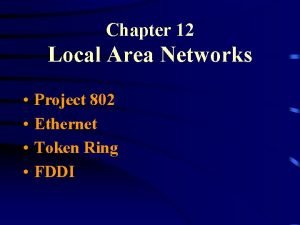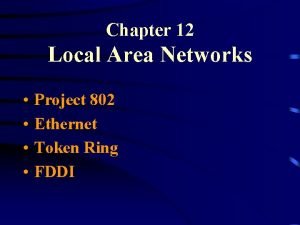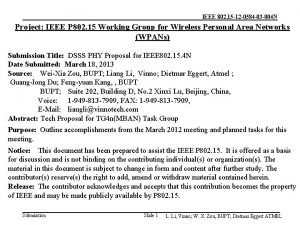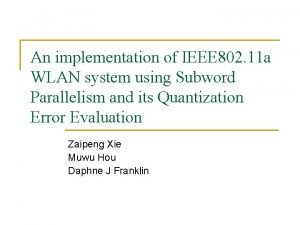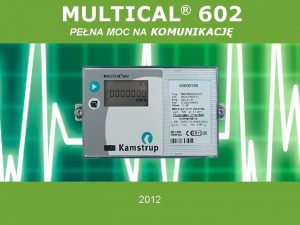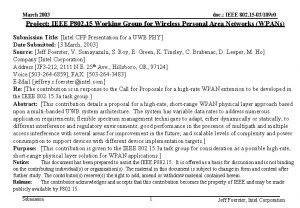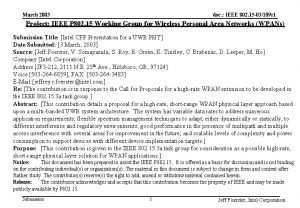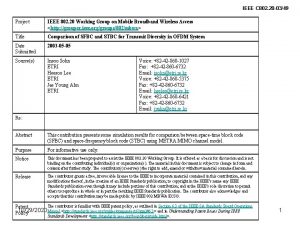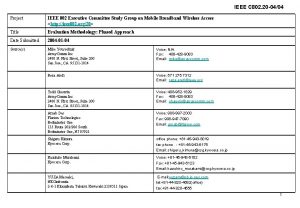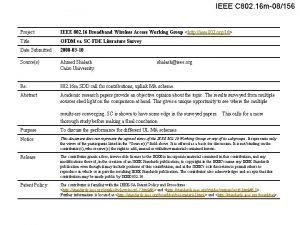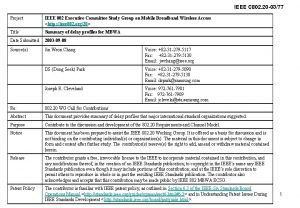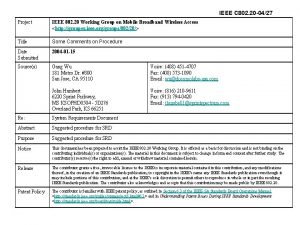IEEE C 802 20 03109 Project IEEE 802

















- Slides: 17

IEEE C 802. 20 -03/109 Project IEEE 802. 20 Working Group on Mobile Broadband Wireless Access <http: //grouper. ieee. org/groups/802/20/> Title Requirements Group Update Date Submitted 2003 -11 -10 Source(s) Khurram Sheikh, John Humbert 6220 Sprint Parkway, MS KSOPHD 0504 - 5 D 276 Overland Park, KS 66251 Re: System Requirements Update Abstract This contribution provides an update on the status of the System Requirements document. Purpose Status Update Notice This document has been prepared to assist the IEEE 802. 20 Working Group. It is offered as a basis for discussion and is not binding on the contributing individual(s) or organization(s). The material in this document is subject to change in form and content after further study. The contributor(s) reserve(s) the right to add, amend or withdraw material contained herein. Release The contributor grants a free, irrevocable license to the IEEE to incorporate material contained in this contribution, and any modifications thereof, in the creation of an IEEE Standards publication; to copyright in the IEEE’s name any IEEE Standards publication even though it may include portions of this contribution; and at the IEEE’s sole discretion to permit others to reproduce in whole or in part the resulting IEEE Standards publication. The contributor also acknowledges and accepts that this contribution may be made public by IEEE 802. 20. Patent Policy The contributor is familiar with IEEE patent policy, as outlined in Section 6. 3 of the IEEE-SA Standards Board Operations Manual <http: //standards. ieee. org/guides/opman/sect 6. html#6. 3> and in Understanding Patent Issues During IEEE Standards Development <http: //standards. ieee. org/board/pat/guide. html>. Voice: (816) 210 -9611 Fax: (913) 794 -0420 Email: khurram. p. sheikh@mail. sprint. com jhumbe 01@sprintspectrum. com

System Requirements update C 802. 20 -03/109 • Objectives of 802. 20 Requirements • SRD Status • Significant Changes made since the last Plenary • Open sections • Concerns • Next Steps -2 -

Review of Objectives C 802. 20 -03/109 • Create consensus Requirements document for 802. 20 MBWA standard – Service Vision – Define key technical parameters and performance targets/ metrics – PHY & MAC Layer Technical Requirements – Layer 2+ support requirements – Co-ordinate with other CG groups to develop standard -3 -

802. 20 Requirements Vision C 802. 20 -03/109 Home Domain High BW Connectivity Video Streaming Conferencing Apps Field Service Apps Portable Remote Access Services Work Domain Seamless, Ubiquitous Broadband Wireless Portable Office Experience Campus W- PBX Services High BW Connectivity Mobile Office (Voice and Data Apps) Portable Services in Public Hot-Spots Mobile B-to-C M-Commerce Services Elsewhere Domain -4 -

802. 20 Service Vision C 802. 20 -03/109 • DSL/ Cable equivalent data performance • Full Mobility • Ubiquitous service model • All IP architecture support • IP Qo. S support • ? x+ performance/ cost advantage to 3 G wireless systems -5 -

SRD Status C 802. 20 -03/109 • 5 conference calls since the September meeting in Singapore • 31 out of 57 (54%) sections have reached consensus in the correspondence group. • Version 9 of the System Requirements posted on the IEEE web site. • Singapore discussions – Reference Architecture, Channel Bandwidth, FER, Sustained Spectral Efficiency, Qo. S, Multicast, Repeater Delay, Synchronization, OAM -6 -

Update on Closed Sections C 802. 20 -03/109 Section Name Status 2. 2 Broadcast/Multicast Added in Singapore 4. 1. 1 System Gain Removed 4. 1. 12 Coverage Enhancing Technologies Formally repeaters scope expanded 4. 2. 2 Link adaptation and power control Consensus version 4. 2. 5 Synchronization Contribution from Singapore Frequency Reuse Removed See Appendix for more detailed explanation -7 -

SRD Status update C 802. 20 -03/109 • Open issues: – System Architecture, Spectral Efficiency, Block Assignments (formally Channel Bandwidth), Duplexing, Aggregate Data Rates, Number Simultaneous Active users, Latency, FER, Antenna Diversity, Best Server Selection, Qo. S, Performance under mobility & Delay Spread, MAC/PHY Measurements, IP Level HO. 802. 1 Q Tagging, OA&M support, MAC Complexity, Call Blocking, Priority Access (new section), Multicarrier Support (new). -8 -

Concerns C 802. 20 -03/109 • Key Issues Unresolved – Key system technical parameters still undecided e. g. Channel BW & Duplexing • Polarized Group – Trivial issues take on “larger than life” status e. g. AI – Conservative targets gain consensus • Lack of specificity – To gain consensus the language in the SRD tends to be vague – The quality of any subsequent work is highly dependant on the level of detail in the SRD -9 -

Next Steps C 802. 20 -03/109 • Need to make decisions on key technical parameters this plenary to close out Phase 1 requirements • Need to focus on Beyond 3 G • Need to hold regular coordination meetings between the various CG’s • Need to get schedule published for overall 802. 20 project -10 -

C 802. 20 -03/109 Appendix -11 -

Broadcast/Multicast(2. 2) C 802. 20 -03/109 • The AI shall support broadcast and multicast services. – Contribution made in Singapore -12 -

System Gain (4. 1. 1) C 802. 20 -03/109 • This section was removed form the SRD – It was difficult to come up with a target number given that there were several different types of BTS’s that are supported. – The required system gain for a mesh network is completely different that what is required for a point to multipoint network. – Total system gain is dependant on factors outside of scope of the 802. 20 PAR. – Definition of System gain placed in Appendix A. • System gain - is defined as the difference, in d. B, between transmitter power output at the base station and the receiver threshold (sensitivity) at the mobile terminal. -13 -

Coverage Enhancing Technologies (4. 1. 12) C 802. 20 -03/109 • This started out as a contribution on repeaters in Singapore. Subsequent discussions within the CG resulted in the following language and definition. – The system shall support the use of coverage enhancing technologies – Coverage Enhancing Technologies: In the context of wireless communications - technologies that augment the radio signal, in areas within the boundary of a cell, where the BS/MS transmitsignal is obstructed and significantly attenuated by terrain or man -made structures. Such technologies employ devices such as repeaters, relays, leaky coax etc. that rely on the BS they extend from for backhaul communications as well as Micro/Pico cells that do provide their own backhaul connectivity. The term Repeater typically refers to an analog device that amplifies and retransmits the original transmission (without frequency translation). A Relay (analog or digital) typically retransmits the received signal in another frequency. A digital relay (or regenerator) decodes the information from the received signal, regenerates and retransmits it. In the case of packet communications, relays may also perform Layer-3 functions as well as delayed transmission. -14 -

Link adaptation and power control (4. 2. 2) C 802. 20 -03/109 • The AI shall support automatic selection of optimized user data rates that are consistent with the RF environment constraints and application requirements. The AI shall provide for graceful reduction or increasing user data rates, on the downlink and uplink, as a mechanism to maintain an appropriate frame error rate performance. Link adaptation shall be used by the AI for increasing spectral efficiency, data rate, and cell coverage reliability. The AI shall support adaptive bandwidth allocation, and adaptive power allocation. The system will have adaptive modulation and coding in both the uplink and the downlink -15 -

Synchronization (4. 2. 5) C 802. 20 -03/109 • The air interface shall support downlink synchronization and uplink synchronization. Synchronization between Base Stations is optional. • Contribution C 802. 20 -03/84 presented at the Singapore WG session. -16 -

Frequency Reuse C 802. 20 -03/109 • This section was removed from the SRD because: – There are tradeoffs between spectral efficiency and frequency reuse – It was felt that this was not needed if section on Spectral efficiency takes into account the reuse factor – The reuse factors vary depending on the level of sectorization. • The reuse factor in a 6 sector system is different that in a 3 sector system. -17 -











